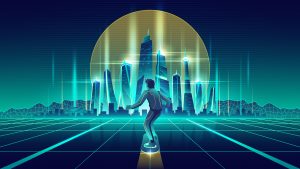Virtual reality or VR is a new type of visual technology that involves the simulation of a virtual environment. This virtual experience is possible with the interaction of people using VR goggles and other complementary devices. This computer-generated simulation creates a 3-dimensional image where its users can interact with almost realistic computer-generated objects. The interaction is made possible using electronic equipment, gloves, and other special sensors.
The simulation of certain environments in a virtual reality space engages different human senses. The different hardware and software that works together to make this happen can produce images, sounds and other almost-realistic environments that engage these sense organs. The users of these pieces of technology feel like they exist in the virtual reality that their senses perceive.
Virtual reality is different from augmented reality. One thing you do not want to do is confuse one for the other. Although they both share, in some ways, some similarities. They both are quite different from each other.
Virtual Reality vs Augmented Reality
Augmented reality comprises technology that overlays virtual objects on our natural environment. It is capable of presenting a layer of the virtual object that can help its users to make more sense of their immediate natural environment. For example, an augmented reality program can help you detect information about different areas down a road by simply taking a picture of it.
In comparison, virtual reality creates a new environment entirely. A virtual reality program is capable of creating a simulation that allows its users to go in and interact directly with it. This interaction may include speaking with people, playing games, going on a ride and several other possibilities available on the software.
Advantage of using Virtual Reality
Focusing on the advantages of using virtual reality, here are some of its top uses for different users
- For engaging sensory organs: Virtual reality uses computer-generated imagery to produce the virtual experience in interesting ways. In the created reality, everything is possible.
- For educational purposes: Virtual reality makes education and learning easier and more comfortable for learners by engaging their senses in a virtual world
- Artificial experiments: being able to perform certain actions without having real-world consequences has its uses. With virtual reality, its users can carry out an experimental simulation that has no real-life consequences through the artificial environment.
Disadvantages of using Virtual Reality
Virtual reality is still a developing space. Hence, there are some challenges that its users are still experiencing. Some of which include:
- Cost: For average individuals, virtual reality is a costly reality that they would like to have but might not be able to afford. A headset can cost up to $1,500 depending on the maker. Because VR is still in its early adoption stage, the cost of the sensory materials and software is on the higher side of the scale.
- Available content: The number of content available for use by Virtual reality users is restricted to the number created. Customization of content for virtual reality is expensive. Because of this, users do not have options of what they can consume as best practices for the creation of content are still in the works.
- Individualistic experience: One of the major selling points of virtual reality is to bring people together to interact as a group. However, virtual reality can also take its users elsewhere if the correct steps are not taken accordingly.
- Time factor: To engage the sense necessary to have a virtual reality experience, some sensory equipment needs to be present. The time each user requires to wear the equipment to the time it takes to experience the virtual reality environment is disproportional.
Use cases for Virtual Reality
There are several use cases for Virtual Reality that encourages its continuous development and effective use for exhibition and events. Some of these use cases include:
- Demos: A realistic demo with virtual reality provides an interactive experience for the people it was made for engagingly. Often time, this demonstration mimics real-life occurrences and the possibility of what could come after the project. A walk-through of how the final design set will look like will make your presentation more convincing with your virtual reality demonstration.
- Inspection sites: The reality that virtual reality makes it possible to inspect destinations and sites just like its users are there. You will not need to be in another country to be able to see what it looks like in a virtual reality environment.
- Design session: Virtual reality makes it possible to gather people in groups to have sessions and hold important discussions. Instead of wasting a large amount of money on hosting a physical meetup, virtualization in a realistic environment solve this issue for its users.
- Use in Sport: virtual reality is being used in sports by coaches and players to make their training exercises more efficient across several sports types. They can watch and experience certain scenarios to improve their response and skillset each time.
- Use in medical training: Virtual reality is capable of creating an interactive environment that imitates practical surgery procedures. This provides surgeons and medical students in training to experience a consequence-free learning environment without the risk of making a mistake on real patients.
- Education: The use of VR in schools provide the virtual environment to engage students within a three-dimensional environment. Particularly for students with special needs, VR can help them learn at the same speed as other students while interacting with the scenery that exists in the virtual environment.
The Metaverse

Meta – Why did Facebook rename its company
In late October, Facebook announced its big-name change. The company has adopted the name ‘meta’ in line with the new virtual reality technologies unfolding rapidly.

The Metaverse – what is it and what can we expect for 2022
Metaverse – you may or may not have heard of it. But the talks are everywhere, from technology journals to giant tech firms. The term

